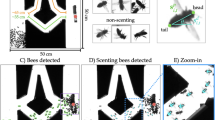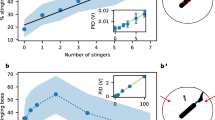Abstract
Honey bees (Apis mellifera L.) aggregate around the queen by collectively organizing a communication network to propagate volatile pheromone signals. Our previous study shows that individual bees “scent” to emit pheromones and fan their wings to direct the signal flow, creating an efficient search and aggregation process. In this work, we introduce environmental stressors in the form of physical obstacles that partially block pheromone signals and prevent a wide open path to the queen. We employ machine learning methods to extract data from the experimental recordings, and show that in the presence of an obstacle that blocks most of the path to the queen, the bees need more time but can still effectively employ the collective scenting strategy to overcome the obstacle and aggregate around the queen. Further, we increase the complexity of the environment by presenting the bees with a maze to navigate to the queen. The bees require more time and exploration to form a more populated communication network. Overall, we show that given volatile pheromone signals and only local communication, the bees can collectively solve the swarming process in a complex unstructured environment with physical obstacles and hit a limit when the obstacle is a much more complex maze.



Similar content being viewed by others
References
Conte YL (2008) Hefetz: primer pheromones in social hymenoptera. Annu Rev Entomol 53(1):523–542
Dougherty ER (1992) An introduction to morphological image processing. Soc Photo Optical
Harker M, O’Leary P (2008) Least squares surface reconstruction from measured gradient fields. CVPR, Salt Lake, pp 1–7
Harker M (2011) O’Leary P Least squares surface reconstruction from gradients - Direct algebraic methods with spectral, Tikhonov, and constrained regularization. CVPR, Salt Lake
He K, Ren S (2016) JS Deep residual learning for image recognition. CVPR, Salt Lake
Lensky Y, Cassier P (1995) The alarm pheromones of queen and worker honey bees. Bee World 76(3):119–129
McIndoo NE (1914) The scent-producing organ of the honey bee 66:2
Nguyen DMT, Iuzzolino ML, Mankel A, Bozek K, Stephens GJ, Peleg O (2021) Flow-mediated olfactory communication in honeybee swarms. Proceedings of the National Academy of Sciences 118(13)
Otsu N (1979) A threshold selection method from gray-level histograms. IEEE Trans Syst Man Cybernet 9(1):62–66
Peters JM, Gravish N, Combes SA (2017) Wings as impellers: honey bees co-opt flight system to induce nest ventilation and disperse pheromones. J Exp Biol 220(Pt 12):2203–2209
Sezgin M, Sankur B (2004) Survey over image thresholding techniques and quantitative performance evaluation. J Elect imag 13(1):146–165
Trhlin M, Rajchard J et al (2011) Chemical communication in the honeybee (apis mellifera l): a review. Vet Med 56(6):265–273
Wolf H (2011) Odometry and insect navigation. J Exp Biol 214(10):1629–1641
Zhang S, Mizutani A, Srinivasan MV (2000) Maze navigation by honeybees: learning path regularity. Learn Memory 7(6):363–374
Acknowledgements
This work was supported by the National Science Foundation Graduate Research Fellowship under Grant No. DGE 1650115 (D.M.T.N.) and Physics of Living Systems Grant No. 2014212 (O.P.). Any opinion, findings, and conclusions or recommendations expressed in this material are those of the authors(s) and do not reflect the views of the NSF. We also acknowledge the BioFrontiers Institute (internal funds), the Interdisciplinary Research Theme on Autonomous Systems (O.P.).
Author information
Authors and Affiliations
Corresponding author
Additional information
Publisher's Note
Springer Nature remains neutral with regard to jurisdictional claims in published maps and institutional affiliations
About this article
Cite this article
Nguyen, D.M.T., Fard, G.G., Iuzzolino, M.L. et al. Robustness of collective scenting in the presence of physical obstacles. Artif Life Robotics 27, 286–291 (2022). https://doi.org/10.1007/s10015-021-00712-z
Received:
Accepted:
Published:
Issue Date:
DOI: https://doi.org/10.1007/s10015-021-00712-z




